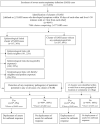Lessons learned from identifying clusters of severe acute respiratory infections with influenza sentinel surveillance, Bangladesh, 2009-2020
- PMID: 37744992
- PMCID: PMC10515138
- DOI: 10.1111/irv.13201
Lessons learned from identifying clusters of severe acute respiratory infections with influenza sentinel surveillance, Bangladesh, 2009-2020
Abstract
Background: We explored whether hospital-based surveillance is useful in detecting severe acute respiratory infection (SARI) clusters and how often these events result in outbreak investigation and community mitigation.
Methods: During May 2009-December 2020, physicians at 14 sentinel hospitals prospectively identified SARI clusters (i.e., ≥2 SARI cases who developed symptoms ≤10 days of each other and lived <30 min walk or <3 km from each other). Oropharyngeal and nasopharyngeal swabs were tested for influenza and other respiratory viruses by real-time reverse transcriptase-polymerase chain reaction (rRT-PCR). We describe the demographic of persons within clusters, laboratory results, and outbreak investigations.
Results: Field staff identified 464 clusters comprising 1427 SARI cases (range 0-13 clusters per month). Sixty percent of clusters had three, 23% had two, and 17% had ≥4 cases. Their median age was 2 years (inter-quartile range [IQR] 0.4-25) and 63% were male. Laboratory results were available for the 464 clusters with a median of 9 days (IQR = 6-13 days) after cluster identification. Less than one in five clusters had cases that tested positive for the same virus: respiratory syncytial virus (RSV) in 58 (13%), influenza viruses in 24 (5%), human metapneumovirus (HMPV) in five (1%), human parainfluenza virus (HPIV) in three (0.6%), adenovirus in two (0.4%). While 102/464 (22%) had poultry exposure, none tested positive for influenza A (H5N1) or A (H7N9). None of the 464 clusters led to field deployments for outbreak response.
Conclusions: For 11 years, none of the hundreds of identified clusters led to an emergency response. The value of this event-based surveillance might be improved by seeking larger clusters, with stronger epidemiologic ties or decedents.
Keywords: Bangladesh; SARI; cluster; influenza; surveillance.
© 2023 The Authors. Influenza and Other Respiratory Viruses published by John Wiley & Sons Ltd.
Conflict of interest statement
None declared.
Figures



References
-
- World Health Organization . International Health Regulations (2005). 2nd ed; 2008.
-
- World Health Organization . Strengthening response to pandemics and other public‐health emergencies: report of the review committee on the functioning of the International Health Regulations (2005) and on pandemic influenza (H1N1) 2009. 2011.
-
- World Health Organization , WHO consultation on priority public health interventions before and during an influenza pandemic. 2004. - PubMed
-
- World Health Organization . Global Health Observatory (GHO) data. 2021. [cited 2021 21 March 2021]; Available from: https://www.who.int/gho/ihr/monitoring/region_europe/en/
Publication types
MeSH terms
Grants and funding
LinkOut - more resources
Full Text Sources
Medical

